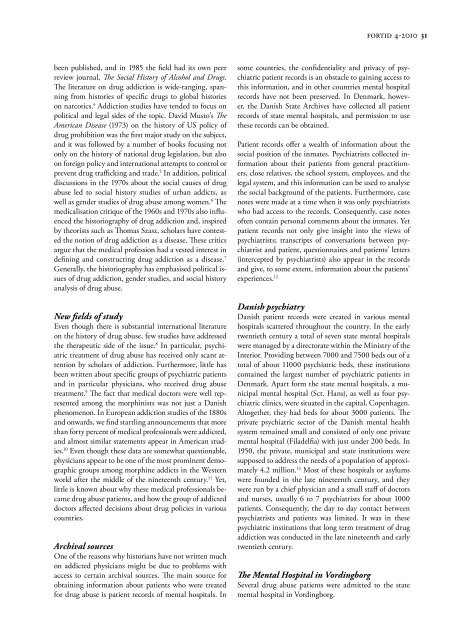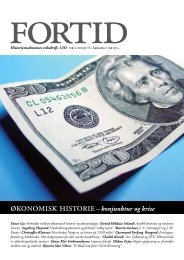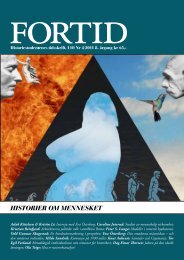You also want an ePaper? Increase the reach of your titles
YUMPU automatically turns print PDFs into web optimized ePapers that Google loves.
een published, and in 1985 the field had its own peer<br />
review journal, The Social History of Alcohol and Drugs.<br />
The literature on drug addiction is wide-ranging, spanning<br />
from histories of specific drugs to global histories<br />
on narcotics. 4 Addiction studies have tended to focus on<br />
political and legal sides of the topic. David Musto’s The<br />
American Disease (1973) on the history of US policy of<br />
drug prohibition was the first major study on the subject,<br />
and it was followed by a number of books focusing not<br />
only on the history of national drug legislation, but also<br />
on foreign policy and international attempts to control or<br />
prevent drug trafficking and trade. 5 In addition, political<br />
discussions in the 1970s about the social causes of drug<br />
abuse led to social history studies of urban addicts, as<br />
well as gender studies of drug abuse among women. 6 The<br />
medicalisation critique of the 1960s and 1970s also influenced<br />
the histori<strong>og</strong>raphy of drug addiction and, inspired<br />
by theorists such as Thomas Szasz, scholars have contested<br />
the notion of drug addiction as a disease. These critics<br />
argue that the medical profession had a vested interest in<br />
defining and constructing drug addiction as a disease. 7<br />
Generally, the histori<strong>og</strong>raphy has emphasised political issues<br />
of drug addiction, gender studies, and social history<br />
analysis of drug abuse.<br />
New fields of study<br />
Even though there is substantial international literature<br />
on the history of drug abuse, few studies have addressed<br />
the therapeutic side of the issue. 8 In particular, psychiatric<br />
treatment of drug abuse has received only scant attention<br />
by scholars of addiction. Furthermore, little has<br />
been written about specific groups of psychiatric patients<br />
and in particular physicians, who received drug abuse<br />
treatment. 9 The fact that medical doctors were well represented<br />
among the morphinists was not just a Danish<br />
phenomenon. In European addiction studies of the 1880s<br />
and onwards, we find startling announcements that more<br />
than forty percent of medical professionals were addicted,<br />
and almost similar statements appear in American studies.<br />
10 Even though these data are somewhat questionable,<br />
physicians appear to be one of the most prominent dem<strong>og</strong>raphic<br />
groups among morphine addicts in the Western<br />
world after the middle of the nineteenth century. 11 Yet,<br />
little is known about why these medical professionals became<br />
drug abuse patients, and how the group of addicted<br />
doctors affected decisions about drug policies in various<br />
countries.<br />
Archival sources<br />
One of the reasons why historians have not written much<br />
on addicted physicians might be due to problems with<br />
access to certain archival sources. The main source for<br />
obtaining information about patients who were treated<br />
for drug abuse is patient records of mental hospitals. In<br />
fortid 4-2010 31<br />
some countries, the confidentiality and privacy of psychiatric<br />
patient records is an obstacle to gaining access to<br />
this information, and in other countries mental hospital<br />
records have not been preserved. In Denmark, however,<br />
the Danish State Archives have collected all patient<br />
records of state mental hospitals, and permission to use<br />
these records can be obtained.<br />
Patient records offer a wealth of information about the<br />
social position of the inmates. Psychiatrists collected information<br />
about their patients from general practitioners,<br />
close relatives, the school system, employees, and the<br />
legal system, and this information can be used to analyse<br />
the social background of the patients. Furthermore, case<br />
notes were made at a time when it was only psychiatrists<br />
who had access to the records. Consequently, case notes<br />
often contain personal comments about the inmates. Yet<br />
patient records not only give insight into the views of<br />
psychiatrists; transcripts of conversations between psychiatrist<br />
and patient, questionnaires and patients’ letters<br />
(intercepted by psychiatrists) also appear in the records<br />
and give, to some extent, information about the patients’<br />
experiences. 12<br />
Danish psychiatry<br />
Danish patient records were created in various mental<br />
hospitals scattered throughout the country. In the early<br />
twentieth century a total of seven state mental hospitals<br />
were managed by a directorate within the Ministry of the<br />
Interior. Providing between 7000 and 7500 beds out of a<br />
total of about 11000 psychiatric beds, these institutions<br />
contained the largest number of psychiatric patients in<br />
Denmark. Apart form the state mental hospitals, a municipal<br />
mental hospital (Sct. Hans), as well as four psychiatric<br />
clinics, were situated in the capital, Copenhagen.<br />
Alt<strong>og</strong>ether, they had beds for about 3000 patients. The<br />
private psychiatric sector of the Danish mental health<br />
system remained small and consisted of only one private<br />
mental hospital (Filadelfia) with just under 200 beds. In<br />
1950, the private, municipal and state institutions were<br />
supposed to address the needs of a population of approximately<br />
4,2 million. 13 Most of these hospitals or asylums<br />
were founded in the late nineteenth century, and they<br />
were run by a chief physician and a small staff of doctors<br />
and nurses, usually 6 to 7 psychiatrists for about 1000<br />
patients. Consequently, the day to day contact between<br />
psychiatrists and patients was limited. It was in these<br />
psychiatric institutions that long term treatment of drug<br />
addiction was conducted in the late nineteenth and early<br />
twentieth century.<br />
The Mental Hospital in Vordingborg<br />
Several drug abuse patients were admitted to the state<br />
mental hospital in Vordingborg.
















